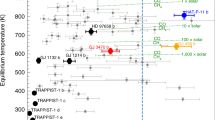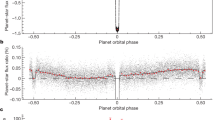Abstract
The nearby extrasolar planet GJ 436b—which has been labelled as a ‘hot Neptune’—reveals itself by the dimming of light as it crosses in front of and behind its parent star as seen from Earth. Respectively known as the primary transit and secondary eclipse, the former constrains the planet’s radius and mass1,2, and the latter constrains the planet’s temperature3,4 and, with measurements at multiple wavelengths, its atmospheric composition. Previous work5 using transmission spectroscopy failed to detect the 1.4-μm water vapour band, leaving the planet’s atmospheric composition poorly constrained. Here we report the detection of planetary thermal emission from the dayside of GJ 436b at multiple infrared wavelengths during the secondary eclipse. The best-fit compositional models contain a high CO abundance and a substantial methane (CH4) deficiency relative to thermochemical equilibrium models6 for the predicted hydrogen-dominated atmosphere7,8. Moreover, we report the presence of some H2O and traces of CO2. Because CH4 is expected to be the dominant carbon-bearing species, disequilibrium processes such as vertical mixing9 and polymerization of methane10 into substances such as ethylene may be required to explain the hot Neptune’s small CH4-to-CO ratio, which is at least 105 times smaller than predicted6.
This is a preview of subscription content, access via your institution
Access options
Subscribe to this journal
Receive 51 print issues and online access
$199.00 per year
only $3.90 per issue
Buy this article
- Purchase on Springer Link
- Instant access to full article PDF
Prices may be subject to local taxes which are calculated during checkout



Similar content being viewed by others
References
Gillon, M. et al. Detection of transits of the nearby hot Neptune GJ 436 b. Astron. Astrophys. 472, L13–L16 (2007)
Torres, G. The transiting exoplanet host star GJ 436: a test of stellar evolution models in the lower main sequence, and revised planetary parameters. Astrophys. J. 671, L65–L68 (2007)
Deming, D. et al. Spitzer transit and secondary eclipse photometry of GJ 436b. Astrophys. J. 667, L199–L202 (2007)
Demory, B.-O. et al. Characterization of the hot Neptune GJ 436 b with Spitzer and groundbased observations. Astron. Astrophys. 475, 1125–1129 (2007)
Pont, F., Gilliland, R. L., Knutson, H., Holman, M. & Charbonneau, D. Transit infrared spectroscopy of the hot Neptune around GJ 436 with the Hubble Space Telescope. Mon. Not. R. Astron. Soc. 393, L6–L10 (2009)
Burrows, A. & Sharp, C. M. Chemical equilibrium abundances in brown dwarf and extrasolar giant planet atmospheres. Astrophys. J. 512, 843–863 (1999)
Figueira, P. et al. Bulk composition of the transiting hot Neptune around GJ 436. Astron. Astrophys. 493, 671–676 (2009)
Rogers, L. A. & Seager, S. A framework for quantifying the degeneracies of exoplanet interior compositions. Astrophys. J. 712, 974–991 (2010)
Saumon, D. et al. Ammonia as a tracer of chemical equilibrium in the T7.5 dwarf Gliese 570D. Astrophys. J. 647, 552–557 (2006)
Zahnle, K., Marley, M. S. & Fortney, J. J. Thermometric soots on hot Jupiters? Preprint at 〈http://arxiv.org/abs/0911.0728〉 (2009)
Werner, M. W. et al. The Spitzer Space Telescope mission. Astrophys. J. Suppl. Ser. 154, 1–9 (2004)
Ford, E. B. Quantifying the uncertainty in the orbits of extrasolar planets. Astrophys. J. 129, 1706–1717 (2005)
Knutson, H. A., Charbonneau, D., Allen, L. E., Burrows, A. & Megeath, S. T. The 3.6–8.0 μm broadband emission spectrum of HD 209458b: evidence for an atmospheric temperature inversion. Astrophys. J. 673, 526–531 (2008)
Harrington, J., Luszcz, S., Seager, S., Deming, D. & Richardson, L. J. The hottest planet. Nature 447, 691–693 (2007)
Deming, D., Seager, S., Richardson, L. J. & Harrington, J. Infrared radiation from an extrasolar planet. Nature 434, 740–743 (2005)
Caceres, C. et al. High cadence near infrared timing observations of extrasolar planets: I. GJ 436b and XO-1b. Astron. Astrophys. 507, 481–486 (2009)
Maness, H. L. et al. The M dwarf GJ 436 and its Neptune-mass planet. Publ. Astron. Soc. Pacif. 119, 90–101 (2007)
Madhusudhan, N. & Seager, S. A temperature and abundance retrieval method for exoplanet atmospheres. Astrophys. J. 707, 24–39 (2009)
Lodders, K. & Fegley, B. Atmospheric chemistry in giant planets, brown dwarfs, and low-mass dwarf stars. I. Carbon, nitrogen, and oxygen. Icarus 155, 393–424 (2002)
Zahnle, K., Marley, M. S., Freedman, R. S., Lodders, K. & Fortney, J. J. Atmospheric sulfur photochemistry on hot Jupiters. Astrophys. J. 701, L20–L24 (2009)
Swain, M. R. et al. A ground-based near-infrared emission spectrum of the exoplanet HD189733b. Nature 463, 637–639 (2010)
Cho, J., Menou, K., Hansen, B. M. S. & Seager, S. Atmospheric circulation of close-in extrasolar giant planets. I. Global, barotropic, adiabatic simulations. Astrophys. J. 675, 817–845 (2008)
Alonso, R. et al. Limits to the planet candidate GJ 436c. Astron. Astrophys. 487, L5–L8 (2008)
Castelli, F. & Kurucz, R. L. New grids of ATLAS9 model atmospheres. Preprint at 〈http://arxiv.org/abs/astro-ph/0405087〉 (2004)
Bean, J. L., Benedict, G. F. & Endl, M. Metallicities of M dwarf planet hosts from spectral synthesis. Astrophys. J. 653, L65–L68 (2006)
Swain, M. R. et al. Molecular signatures in the near-infrared dayside spectrum of HD 189733b. Astrophys. J. 690, L114–L117 (2009)
Atreya, S. K., Mahaffy, P. R., Niemann, H. B., Wong, M. H. & Owen, T. C. Composition and origin of the atmosphere of Jupiter — an update, and implications for the extrasolar giant planets. Planet. Space Sci. 51, 105–112 (2003)
Lodders, K. & Fegley, B. Jr. The origin of carbon monoxide in Neptune’s atmosphere. Icarus 112, 368–375 (1994)
Mandel, K. & Agol, E. Analytic light curves for planetary transit searches. Astrophys. J. 580, L171–L175 (2002)
Reiners, A. Activity-induced radial velocity jitter in a flaring M dwarf. Astron. Astrophys. 498, 853–861 (2009)
Acknowledgements
We thank the Spitzer staff for rapid scheduling; M. Gillon, A. Lanotte and T. Loredo for discussions; D. Wilson for contributed code; and A. Wright for manuscript comments. We thank the following for software: the Free Software Foundation, W. Landsman and other contributors to the Interactive Data Language Astronomy Library, contributors to SciPy, Matplotlib and the Python programming language, and the open-source community. This work is based on observations made with the Spitzer Space Telescope, which is operated by the Jet Propulsion Laboratory, California Institute of Technology, under a contract with NASA. This material is based on work supported by the US NSF and by the US NASA through an award issued by JPL/Caltech.
Author Contributions K.B.S. wrote the paper and Supplementary Information with contributions from J.H., N.M. and R.A.H.; N.M. and S.S. produced the atmospheric models; S.N., K.B.S. and W.C.B. reduced the data; K.B.S., J.H. and D.D. analysed the results; D.D. ran an independent analysis; R.A.H. produced the orbital parameter results; and J.H., K.B.S., S.N., R.A.H., E.R. and N.B.L. wrote the analysis pipeline.
Author information
Authors and Affiliations
Corresponding author
Ethics declarations
Competing interests
The authors declare no competing financial interests.
Additional information
The original data are available from the Spitzer Space Telescope archive, programs 30129 and 40685.
Supplementary information
Supplementary Information
This file contains Supplementary Information comprising: Centring and Photometry; Position Sensitivity; Time-Varying Sensitivity; Determining the Best Model and a Supplementary Discussion, Supplementary Figures 1–17 with legends, Supplementary Tables 1–9, and Supplementary References. (PDF 2534 kb)
Supplementary Data
This zipped file contains Supplementary Data si1-si6, which show Spitzer lightcurves in digital form. Wavelengths used are 3.6µm (si1a-c), 4.5µm (si2), 5.8µm (si3), 8.0µm (si4), 16µm (si5) and 24µm (si6). (ZIP 26575 kb)
Rights and permissions
About this article
Cite this article
Stevenson, K., Harrington, J., Nymeyer, S. et al. Possible thermochemical disequilibrium in the atmosphere of the exoplanet GJ 436b. Nature 464, 1161–1164 (2010). https://doi.org/10.1038/nature09013
Received:
Accepted:
Issue Date:
DOI: https://doi.org/10.1038/nature09013
This article is cited by
-
Highlights of exoplanetary science from Spitzer
Nature Astronomy (2020)
Comments
By submitting a comment you agree to abide by our Terms and Community Guidelines. If you find something abusive or that does not comply with our terms or guidelines please flag it as inappropriate.



